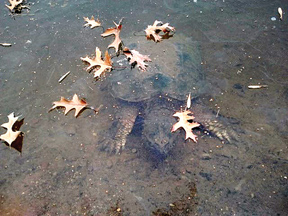Snapping turtles survive winter by burying themselves in mud at the bottom of ponds. They go into a hibernation-like state to conserve energy until spring.
In the colder months, snapping turtles face challenges due to the dropping temperatures. To adapt, they slow down their metabolism and seek refuge in the muddy bottoms of ponds or lakes. By entering a state of dormancy, they can survive without food for several months.
This unique survival strategy allows snapping turtles to endure the harsh winter conditions and emerge once the temperatures rise. Understanding how these fascinating reptiles navigate the winter months sheds light on their remarkable resilience and ability to thrive in challenging environments.

Credit: www.wxpr.org
Physical Adaptations
Physical adaptations enable snapping turtles to survive the harsh conditions of winter. These adaptations include their shell structure and fat reserves.
Shell Structure
The shell of a snapping turtle is a vital physical adaptation that helps it survive winter. It is composed of two parts: the carapace (top shell) and the plastron (bottom shell). This hard exterior provides excellent protection and insulation, allowing the turtle to endure the cold temperatures and harsh conditions.
Fat Reserves
Snapping turtles possess significant fat reserves, particularly in the tail and body. These reserves serve as an energy source during hibernation. The stored fat sustains the turtle throughout the winter, providing the necessary energy to survive without food until the warmer months return.

Credit: www.lakechamplaincommittee.org
Behavioral Adaptations
Behavioral adaptations play a crucial role in the survival of snapping turtles during the harsh winter months. These remarkable creatures have developed specific behaviors that enable them to endure the cold and scarcity of food, ensuring their survival until the return of more favorable conditions.
Burrowing
Snapping turtles exhibit a unique behavioral adaptation known as burrowing. As the temperatures begin to drop, these turtles seek out suitable locations to dig into the soft mud at the bottom of bodies of water. By burrowing into the mud, they create a protected environment where they can remain relatively insulated from the frigid temperatures above. This behavior allows them to conserve energy and avoid the potentially lethal effects of prolonged exposure to extreme cold.
Reduced Metabolic Rate
Another essential behavioral adaptation utilized by snapping turtles during the winter is the reduction of their metabolic rate. As the cold weather sets in, these turtles enter a state of torpor, significantly slowing down their metabolic processes. This reduction in metabolic rate helps them conserve energy and minimize the need for food intake, allowing them to survive for extended periods without feeding. By lowering their metabolic activity, snapping turtles can endure the winter months without the same level of sustenance required during the warmer seasons.
Habitat Selection
During winter, snapping turtles survive by selecting specific habitats. They burrow into mud or find deep water bodies to avoid freezing. This allows them to endure the harsh conditions and emerge in spring.
Aquatic Environments
Snapping turtles are aquatic reptiles that spend most of their lives in water bodies such as ponds, lakes, marshes, and swamps. During winter, these turtles must find a suitable place to hibernate, where they can survive the harsh weather conditions. Snapping turtles prefer to hibernate in aquatic environments that remain unfrozen throughout the winter season.Muddy Bottoms
Muddy bottoms are the preferred habitat for snapping turtles to hibernate during winter. The turtles dig a hole in the mud to bury themselves, where they can survive for months without food or water. The mud provides a stable environment with a consistent temperature, which is essential for the turtle’s survival. The turtles also bury themselves in leaves and debris on the bottom of the pond or lake.Important Points To Note
- Snapping turtles are aquatic reptiles that hibernate during winter.
- They prefer to hibernate in aquatic environments that remain unfrozen.
- Muddy bottoms provide a stable environment with a consistent temperature.
- The turtles dig a hole in the mud to bury themselves and survive for months.
- They also bury themselves in leaves and debris on the bottom of the pond or lake.
The Bottom Line
Habitat selection is crucial for snapping turtles to survive the winter season. Muddy bottoms provide a stable environment with a consistent temperature, making them the preferred habitat for hibernation. It’s essential to protect the habitats of snapping turtles and other aquatic wildlife to ensure their survival in the long run.
Credit: wildlifeinwinter.com
Challenges Faced
Snapping turtles face numerous challenges during the winter months, as they must navigate through a variety of obstacles to survive the harsh conditions.
Predators
Snapping turtles have to deal with predators such as raccoons, foxes, and otters, which are known to raid their nests and feed on their eggs. This poses a significant threat to the survival of the species, as it reduces the number of hatchlings that will emerge in the spring.
Habitat Destruction
The destruction of their natural habitat due to human activities like construction and pollution is another major challenge faced by snapping turtles. This leads to a loss of nesting sites and can disrupt their ability to find suitable hibernation spots, putting additional stress on the population.
Conservation Efforts
Protecting the habitats of snapping turtles and raising awareness about their importance are crucial aspects of conservation efforts.
Protection Of Habitats
Preserving the natural habitats of snapping turtles is essential for their survival. Establishing protected areas and enforcing regulations to minimize human disturbances in their habitats are key strategies. By protecting their nesting sites and ensuring water quality, we can safeguard these important ecosystems for snapping turtles.
Awareness Programs
Educating the public about snapping turtles and their significance in the ecosystem is vital. Organizing educational programs in schools, conducting workshops, and creating informational materials can help raise awareness. By highlighting the threats they face and the ways people can contribute to their conservation, we can promote a sense of responsibility towards protecting these remarkable creatures.
Human Interaction
Snapping turtles survive winter by burying themselves in mud underwater. They slow down their metabolism, enabling them to breathe through their skin and survive without food until spring. This hibernation strategy helps them conserve energy and stay protected from harsh winter conditions.
Snapping turtles are known for their ability to survive in extreme environments. However, human interaction can pose a significant threat to their survival. As humans continue to encroach on their habitats, snapping turtles are facing a new set of challenges that they must overcome in order to survive the winter.Impact Of Climate Change
Climate change is one of the biggest threats to snapping turtles. As temperatures rise, it becomes increasingly difficult for them to survive the winter. Snapping turtles depend on the cold winter temperatures to trigger their hibernation process. If the temperature remains warm, they may not hibernate at all, which can lead to serious health problems.Threats From Pollution
Pollution is another major threat to snapping turtles. As humans continue to pollute their habitats with chemicals and waste, the water quality decreases, making it more difficult for them to survive. Pollution can also affect their food sources, making it harder for them to find enough food to sustain themselves through the winter. To ensure the survival of snapping turtles, it is important that we take steps to reduce our impact on their habitats. This includes reducing pollution and preserving their natural habitats. By doing so, we can help ensure that these remarkable creatures continue to thrive for generations to come.Conclusion
As winter sets in, snapping turtles go into hibernation to survive the cold. Their ability to slow down their metabolism and breathe through their skin helps them endure the harsh winter conditions. Understanding how these remarkable creatures adapt and thrive in challenging environments is truly fascinating.






Leave a Reply